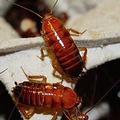 美國佛州州立大學「食品與農業科學中心」昆蟲研究學者柯勒(Phil Koehler )和佩雷拉( Roberto Pereira)警示,有不少新品種的蟑螂出現在佛羅里達州。研究學者表示,隨著美軍從中東撤回,有些依附在機械設備上的外來種蟑螂也跟著進入佛州,像是土耳其斯坦蟑螂(Turkestan cockroach )等;而今,這些蟑螂早已定居在德州、新墨西哥州及亞歷桑納州。
美國佛州州立大學「食品與農業科學中心」昆蟲研究學者柯勒(Phil Koehler )和佩雷拉( Roberto Pereira)警示,有不少新品種的蟑螂出現在佛羅里達州。研究學者表示,隨著美軍從中東撤回,有些依附在機械設備上的外來種蟑螂也跟著進入佛州,像是土耳其斯坦蟑螂(Turkestan cockroach )等;而今,這些蟑螂早已定居在德州、新墨西哥州及亞歷桑納州。
此外,由於一股飼養昆蟲當作蜥蜴食物的熱潮在爬蟲迷中與日發酵,讓昆蟲供應商運送到佛州的蟑螂種類倍增不少。科學家說,佛州居民也許很快就會看到三吋長的馬達加斯加蟑螂(Madagascar hissing cockroach)、龍蝦蟑螂(lobster roach)以及橘斑蟑螂( orange spotted roach),而那些蟑螂都不是出於佛州,是外來種。「美國共有69種蟑螂,其中29種是來自國外」,柯勒表示,「而現在又有新品種運進來了。」
「那些蟑螂不停地向我們說-我們住在一個全球化的經濟與社會體系中」,佩雷拉說,「你可以透過網路買到所有品種的蟑螂-也就是說你可能在太平洋西北部下單,而過不到兩天商品就送到了。所以說,我們可以很容意地透過那種方式運送東西。」
最新一期的《佛羅里達害蟲評論》雜誌中,柯勒和佩雷拉在一篇文章中告誡病媒防治業者與屋主須注意新品種的蟑螂。胡列特環境清潔服務機構( Hulett Environmental Services )位於西棕櫚灘,而其教育暨科學部門的主管巴克斯(Ron Box)表示,他蒐集了文章中提到的蟑螂品種照片給技術人員,所以他們看到的話就會認得。
一位經營 blaberus.com 蟑螂供應公司的昆蟲迷圖特(James Tuttle)將昆蟲運送到全國各地。他表示,買蟑螂當作蜥蜴的食物很可能是近期來最熱門的一件事。圖特說,過去多以蟋蟀餵養爬蟲類,但蟋蟀太吵、死掉時會產生異味,且繁衍的速度還不及蟑螂在養殖場繁殖一次有效率。此外,蟋蟀的成本較高。
圖特說:「這就是經濟,你能一個月花50美元買蟋蟀,也就是一年600美元,或者花50元買蟑螂,但接下來六個月的時間都不需要再添購食物。」
圖特認同佛羅里達大學研究學者的觀點,認為最大的威脅是土耳其斯坦蟑螂。公土耳其斯坦蟑螂常被誤認為美國本土蟑螂,而母土耳其斯坦蟑螂則被誤認是東方的蟑螂。然而一旦蟑螂在某處繁衍,就會普遍出現在下水道系統中,且他們會夾帶著引發腹瀉的細菌。
圖特說,人工飼養蟑螂養不是件容易的事,而且蟑螂在大自然中有很多天敵,像是蜘蛛、烏龜、青蛙、鳥,以及齧齒動物等,所以除非蟑螂一次大量逃脫,否則他們在野外是很難生存的。
圖特表示,佛州已有幾位寵物爬蟲的飼主在自家擁有蟑螂養殖場,且目前為止,就算有一些昆蟲逃脫出去,對環境也無大礙。但如果在有利於蟑螂的情況下發生,圖特承認,「絕對有可能影響環境。」
Several new cockroach species are entering Florida, warn Phil Koehler and Roberto Pereira, insect researchers with University of Florida's Institute of Food and Agricultural Sciences.
They say exotic roaches such as the Turkestan cockroach hitchhike into the state on gear brought back by members of the armed forces returning from the Middle East. These roaches have already settled in Texas, New Mexico and Arizona.
In addition, a growing interest among reptile enthusiasts to raise the insects as lizard food has multiplied the number of roach species being shipped into Florida by insect suppliers.
The scientists say Floridians might soon be seeing the three-inch long Madagascar hissing roach, the lobster roach and the orange spotted roach, although none these species are known to be established in the state.
"We have 69 species of cockroaches in the United States and 29 of them were brought in from other countries," said Koehler. "And now we have these new species being shipped into the state."
"They keep telling us we live in a global economy and society," said Pereira. "All of these cockroaches you can get over the Internet - you can order something from the Pacific Northwest and have it here in two days or less. You can transfer things that way very easily."
Koehler and Pereira alerted pest control operators and homeowners to the new roaches in an article in last month's "Florida Pest Pro" magazine. Ron Box, director of education and scientific affairs with Hulett Environmental Services in West Palm Beach, said he is gathering photographs of the cockroach species mentioned in the article for his technicians, so they will recognize them if they see them.
James Tuttle, a reptile enthusiast who runs a roach supply company called blaberus.com ships insects all across the country. He says buying roaches as reptile food "is probably the most popular thing going these days."
Crickets, which used to be a more popular reptile food source, are noisy, smell bad when they die and don't reproduce quickly the way roaches do once a farm is up and running, he says. And they cost more.
"It's the economy," Tuttle said. "You can spend $50 a month buying crickets, so that's $600 a year, or you could spend $50 [on roaches] and in six months, never have to buy food again."
Tuttle said he agrees with the University of Florida researchers that the Turkestan roach poses the biggest threat. The male Turkestan roach is often mistaken for the ordinary brown American cockroach, and the female can be mistaken for the oriental cockroach. Where this roach is established, it is prevalent in sewer systems and is capable of carrying bacteria that cause dysentery.
Breeding roaches in captivity is not easy, said Tuttle, and roaches have many natural predators - spiders, turtles, frogs, birds and rodents among others - that unless a large number of captive roaches escaped at once, they would have a tough time getting established in the wild.
Tuttle says several pet reptile owners in Florida already have roach farms in their homes that have not disrupted the environment, even when a few insects escape here and there. But under perfect conditions, he conceded, "it's possible."
全文及圖片詳見:ENS


